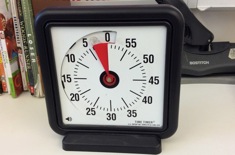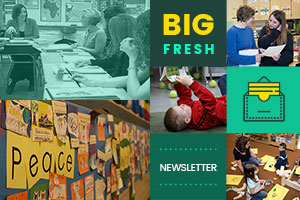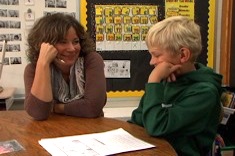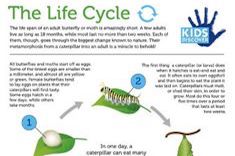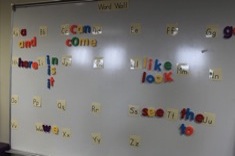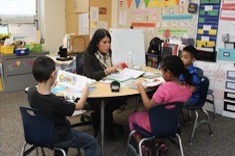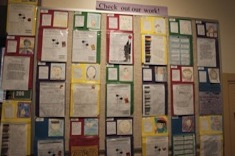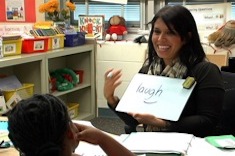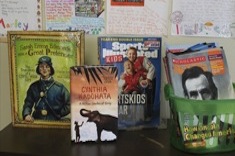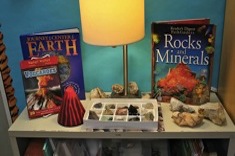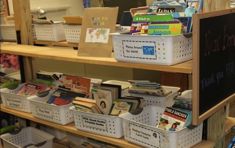Library
Choice Literacy Articles & Videos
The Choice Literacy library contains over 3,000 articles and 900 videos from 150+ contributors. Classic Classroom and Literacy Leadership subscribers have access to the entire library. Content is updated continuously, with five to six new features published each week.
Latest Content
Post It Prove It
Leslie Lloyd preserves instructional time by having her third-grade students share their Post It Prove It notes on a bulletin board throughout the reading workshop.
Finding Pockets of Time
Gigi McAllister gives suggestions for finding pockets of time in overstuffed schedules.
Digital Status of the Class
Maria Caplin explains how a digital status sheet saves minutes every week that add up to extra hours of instructional time over the year.
The Big Fresh February 14, 2015 Joy’s Path
We look at conferring with students in this week’s Big Fresh.
Making Time for Individual Conferences
Franki Sibberson explains how longer conferences early in the year pay dividends all year long.
Guiding Principles for Conferring
Melanie Meehan shares what’s essential in conferring.
Moving Away from Bed to Bed: Conferring with Ty
Ruth Ayres confers with fourth grader Ty about his personal narrative, and works to move him away from a “bed-to-bed” approach in his writing.
Making Memories Stick: Tutoring Kirk
Max Brand tutors a struggling fourth grader who produces very little writing.
The Big Fresh February 7, 2015 Rereading the Classics
Student research is the focus of this week’s Big Fresh.
Infographics and the Common Core: Resources and Standards
Andrea Smith explains why infographics are more useful than ever in the age of the Common Core, and provides many links to free infographic resources on the web.
First-Grade Math Lesson: Introduction and Partner Work
Danielle French’s first-grade students are practicing new math vocabulary during a lesson. This is the first video in a series.
The Big Fresh January 31, 2015 Portmanteaus and Eggcorns
Content word work is the focus of this week’s Big Fresh.
Teaching Search Skill Basics to Students
Bill Bass has advice for teaching web-based search skills to students.
First-Grade Math Lesson: Practice and Discussion
Students practice creating equations and using new vocabulary in the second installment of a math lesson from Danielle French’s first-grade classroom.
Webquests with Middle School Students
Megan Ginther revisits a classic internet research project.
Using Google Earth to Support Readers
Justin Stygles finds Google Earth is a marvelous tool for helping students research settings in novels.
Raising the Quality of Word Work
Shari Frost has some practical suggestions for more thoughtful word work.
The Big Fresh January 24, 2015 DEARO
We consider small groups in this week’s Big Fresh.
Three Questions to Ask When a Guided Reading Group Is Stuck
Jan Burkins and Kim Yaris share three questions teachers should ask themselves when guided reading groups aren’t going well.
Small-Group Writing: Steps for Success
Cathy Mere provides grouping guidelines for primary teachers.
The Power of Written Blind Word Sorts
Max Brand uses written blind word sorts to build student word learning skills.
Going Public with Word Work
Maria Caplin is discouraged at the low level of transfer of new vocabulary in her fifth graders’ writing, so she makes some changes in her classroom.
English Language Learners First-Grade Guided Group
Stella Villalba leads a guided reading group of first-grade English language learners, beginning with building vocabulary.
Frog and Toad and Tina and Maya: A Precocious Kindergarten Reading Group
Suzy Kaback ponders the precociousness of two kindergarten readers.
The Big Fresh January 17, 2015 The Power of Nonfiction Picture Books
We consider fuzzy boundaries between nonfiction and fiction in this week’s Big Fresh.
Blurring Genres and Real-Life Readers
The line between fiction and nonfiction can be fuzzy, but Tony Keefer finds what matters most is finding texts that captivate readers.
Classroom Displays for Nonfiction Learning
Andrea Smith shares some of her favorite nonfiction classroom displays.
Exploring Literary Nonfiction with Middle School Students
Holly Mueller and her middle school students have fun exploring the creative aspects of literary nonfiction.
Science Observations in Kindergarten
Mandy Robek helps her kindergarten students complete science observations.
Anchor Lesson: Poem in Two Voices
Leslie Lloyd's third-grade students continue to explore the differences between literal and figurative language.
Browse Content By
Type
Category
- Assessment Tools
- Big Fresh Archives
- Booklists
- Choice Numeracy
- Classroom Design
- Common Core
- Community Building
- Conferring
- Content Literacy
- Digital Literacy
- English Language Learners
- Equity
- Family Relations
- Free Samples
- Guiding Groups
- Leadership
- Literacy Coaches
- Mentor Texts
- Minilessons
- New Teacher Mentors
- Podcasts
- Poetry
- Quote Collections
- Reading Strategies
- Self Care
- Struggling and Striving Learners
- Talking and Listening
- Teacher Study Groups
- Teaching Reading
- Teaching Writing
- Word Study and Vocabulary
Author
- Melissa Quimby
- Nawal Qarooni
- Gwen Blumberg
- Julie Cox
- The Lead Learners
- Hannah Tills
- Josie Stewart
- Ruth Metcalfe
- Mallory Messenger
- Becca Burk
- Jodie Bailey
- Vivian Chen
- Mary Brower
- Tiffany Abbott Fuller
- Stephanie Affinito
- Ruth Ayres
- Leigh Anne Eck
- Heather Fisher
- Shari Frost
- Julie Johnson
- Suzy Kaback
- Gigi McAllister
- Shirl McPhillips
- Melanie Meehan
- Cathy Mere
- Debbie Miller
- Tara Barnett and Kate Mills
- Tammy Mulligan
- Dana Murphy
- Bitsy Parks
- David Pittman
- Brenda Power
- Heather Rader
- Matt Renwick
- Mandy Robek
- Christy Rush-Levine
- Gretchen Schroeder
- Jen Schwanke
- Brian Sepe
- Katherine Sokolowski
- Stella Villalba
- Jennifer Vincent
Grade Level
Choice Literacy Membership
Articles
Get full access to all Choice Literacy article content
Videos
Get full access to all Choice Literacy video content
Courses
Access Choice Literacy course curriculum and training


